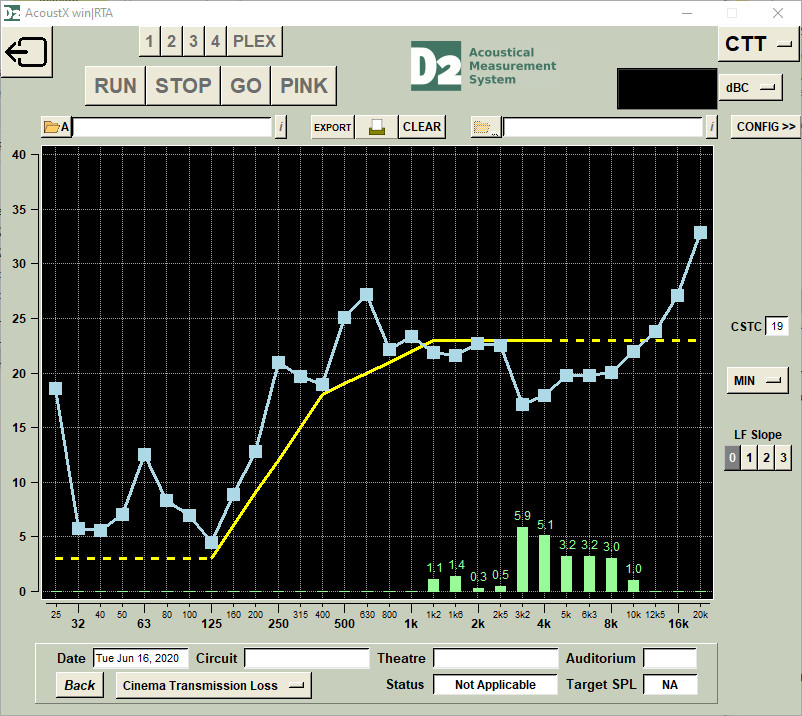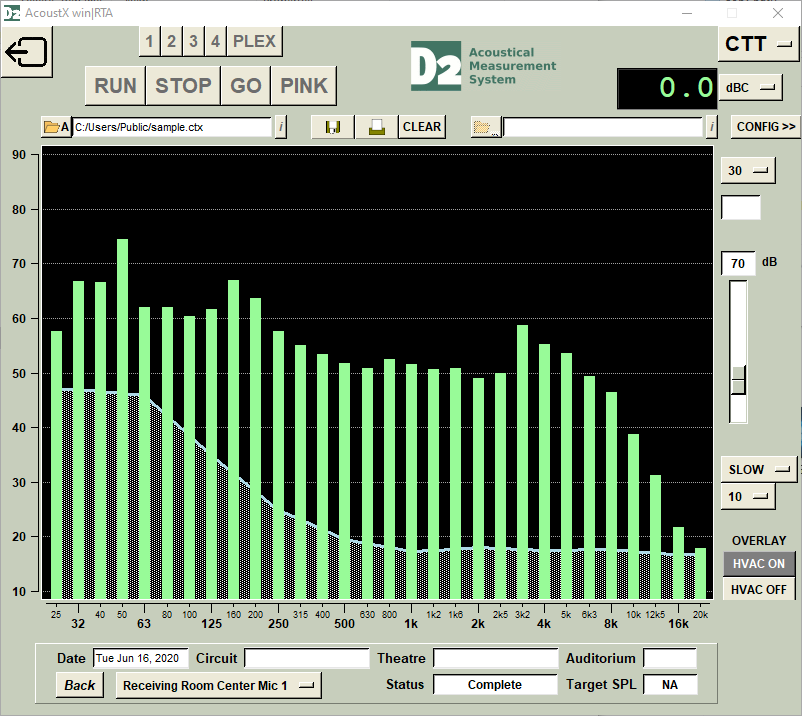|
Technical Resources
|
Noise isolation is important in motion picture theatres. Intrusive noises from an adjacent auditorium or the outside will distract from presentation quality.
In win|RTA Version 2.6, methodology to measure, analyze and present data on Transmission Loss has been added to Comprehensive Theatre Test (CTT).
Standards detailed in ASTM E336 & E413 were used as guidelines for creating these tests. These tests have some inherent shortcomings when applied to cinema testing,
such as a low frequency limit of 125 Hz. The new procedures make some additions to address this.
In CTT, an additional option, Noise Isolation, is available. Selecting this option shows the measurements and data viewing/analysis options available.
There are three measurement sections.
During these tests we will have a “sending” room, where the sound is generated, and a “receiving” room, where the intrusive noise is measured.
The first step is to tune the sending room. Then set the microphones up in the sending room like this:

Turn on all speakers in the sending room and set the level to reference. This should generate an level of 95-97 dBC, which is probably safe,
and loud enough in most cases. It may be safe to increase the level a few dB in modern cinemas, but always be careful not to turn the volume up
too high and damage any loudspeakers.
Measure each microphone one at a time, utilizing the buttons “Source Room Mic 1”, “Source Room Mic 2”, etc.
Next, move the microphones to the receiving room, turn on the pink noise in the sending room again, and measure each microphone utilizing the buttons
“Receiving Room Mic 1”, Receiving Room Mic 2”, etc.
Next, move the microphones in the receiving room to either tuning position, or equally spaced around the room.
Turn on pink noise in the sending room and measure each microphone using the “Receiving Room Center Mic 1”, Receving Room Center Mic 2”, etc, selections.

Next, with the pink noise off in the sending room, do an NC measurement in the receiving room (HVAC ON). This is located in the main CTT menu.
The Transmission Loss button shows a traditional Transmission Loss graph as specified by ASTM E413. The data is evaluated from 125 Hz to 4 kHz.
The STC curve is displayed with the data shown in 1/3 octave resolution. Individual microphones can be selected, or the composite (“MIN”) can be viewed.
The example below shows a wall rated at STC 21. (Note that this example is not a typical cinema demising wall. A cinema wall should have a significantly higher rating).
An STC 21 wall can have a total of 32 dB of “deficiencies”, or bands that lie below the the STC 21 curve.
This wall is an STC 21 wall based on the performance of all microphones.

If there is a single value that is 8 dB or more below the curve, this supercedes the 32 dB requirement, and sets the value.
The image below indicates a value of
STC 28 for microphone position #2, and is determined by the 3150 Hz octave band.

In an attempt to set criteria more meaningful to cinemas, a category call CSTC (Cinema Sound Transmission Class) is created. This extends the frequency limits evaluated.
The example below shows the summary result of the test.

The next image shows microphone two evaluated with a low frequency slope of 1 dB per third octave. The slope of the low frequency CSTC line can be adjusted
from 0-3 dB per third octave. The most appropriate usage will need to be determined by a combination of subjective impressions and budgetary considerations.
Note that a lower slope will mean less intrusive noise (and probably increased construction costs).

The potential masking effect due to HVAC can be shown by viewing the Source Room Center microphone positions.
In this room, the noise will probably not mask intrusive noise from the adjacent auditorium.

Intrusive noises from an adjacent auditorium can lower presentation quality.
Using these tools, the technician and management can learn how to optimize sound quality in their theatres.
|
|
|

